STOCK EXCHANGE - EVAN STEWART
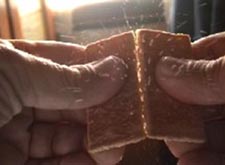 Breaking white bread - an almost impossible thing to do. Soft and spongy white bread is, although disliked by nutrition experts, the basic element of everyday life's alimentation. Favoured by most of the people and thus present from breakfast to supper, white bread is all around.
Breaking white bread - an almost impossible thing to do. Soft and spongy white bread is, although disliked by nutrition experts, the basic element of everyday life's alimentation. Favoured by most of the people and thus present from breakfast to supper, white bread is all around.
Evan Stewart's artwork shown in his solo show related to the project Stock Exchange revolves all around this special food.
Far more suitable as material for his installations, subject for his photographs and symbol for urban life-style than for a balanced diet, he uses slices of white bread to create his artistic projects in the gallery space, transforming it into a hybrid sanctuary, into a weird cinema.
'Breaking White Bread' as Evan Stewart's newest video is projected onto screen consisting of bread slices. The video montage of poems and scenes focuses on the perils and obsessions with white bread. Far away from the biblical meaning of breaking bread as an act of mercy and grace, white bread turns into a symbol of egoism. Evan Stewart exposes hedonistic mindsets of self-absorbed people with consumer attitude. He also uses bread as substratum to display his photographs. The slices are decoratively quilted and frame the series of photographs.
With 'Balls' Evan Stewart shows an older video work, a compilation of video sequences reminding popular music video-clips accompanied by poems, verses written on slices of paper or directly integrated in the scenes, spoken voice-over in gentle tone.
Evan Stewart operates with the ambiguous meaning of words using their different connotation. The initial child's play starting 'Balls', the ball game, may turn into an x-rated act of seduction or porn. Another chapter: 'Brown Safety'. A brownish paste carried in plastic bag, no one could say whether is belongs to nutrition or excrement, is drawn from the pocket in various situations and used to cover ears, noose or mouth. A clip shows a girl on rollerblades, flirtatious and coquettish she dances over a cemetery, making a pass at a gravestone. Seductive? Ridiculous? Pathetic? Infantile? Loveable? Yes.
In Evan Stewart's video-clips, grown-ups still bear a childish behaviour acting out their sensual obsessions in funny-grotesque attempts to satisfy their needs. His protagonists are overstrained by the desire to be attractive and seducing, to persist in urban jungle. Evan Stewart's video-poems are Memento moris of urban life-style in humorous statements. Between neuroses and excesses, dynamism and melancholic moments, they are living their lives like any other. They are caught in acceleration, in a permanent overdose; never able to stop in their excessive but often frustrating quest for salvation: They just can't get enough.
As much as I am the producer of my projects I am also an experimental subject. I'd rather empower the camera than trust my perfectionism to render the ideas. I trust the viewfinder to experience the same splendor and squalor this life has to offer even when I'm removed from it.
"Issues Soufflé" will convert Gallery Uno into a cinema sanctuary housed in a palace of bleached white flour. Here I will force feed the public unconventional parallels between household white bread, the human psyche (which is softer than dough) and my special blend of humor and drama. Don't come hungry.
EVAN STEWART grew up in Chicago. He graduated from Columbia College with concentrations in poetry, video, and art direction. His first DVD, 'Balls', was featured at Undershorts Film Fest.
ARTexhibitionLink.com
www.artexhibitionlink.com
STOCK EXCHANGE - CAMERON CRAWFORD
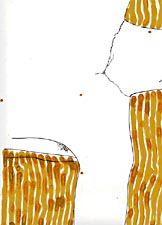 You don't have to dig in the ground to do archaeology. Artefacts and reminiscences of human culture permanently are left on the way like traces, vestiges documentating human life and its social conditions. Cameron Crawford, somehow, practises archaeology concerning the youngest past and, in a frightening and anticipating way, maybe the future. Abandoned and deserted interiors, chairs, cups and coat hangers give evidence of recent animation, of everyday life. Where have the people gone? Were they dispersed by a natural disaster, a volcanic eruption petrifying life like in Pompeii, or an anthropogenic catastrophe like in Chernobyl or Hiroshima? What is to come? Nuclear weapons constantly ready for takeoff …
You don't have to dig in the ground to do archaeology. Artefacts and reminiscences of human culture permanently are left on the way like traces, vestiges documentating human life and its social conditions. Cameron Crawford, somehow, practises archaeology concerning the youngest past and, in a frightening and anticipating way, maybe the future. Abandoned and deserted interiors, chairs, cups and coat hangers give evidence of recent animation, of everyday life. Where have the people gone? Were they dispersed by a natural disaster, a volcanic eruption petrifying life like in Pompeii, or an anthropogenic catastrophe like in Chernobyl or Hiroshima? What is to come? Nuclear weapons constantly ready for takeoff …
Mankind at the beginning of the 21st C.: Ambition and success at all costs, inconsiderateness, physical and emotional violence towards the self and others. Cameron Crawford studies these conditions of (un)social life and visualises them in tiny and thus particularly disturbing installations.
Wood or rodent poison are gathered and glued to small-scaled scenes of despair: A manikin creeps under the table, searching for shelter. Although routine exercise in several countries, it is an absurd act in view of the destructive power, whatever the threatening danger may be. Humans are more fragile than ever, but defenceless, they injure one another with unsurpassed brutality.
Miniature chairs, disarranged in chaos, are made of yellowish granular rat poison, an especially perfidious poison, because killing excruciatingly and time-delayed.
These are scenes of hopelessness with a shade of cynicism, reminding the mortality of everyone, the insignificance of our poor and short lives, the impossibility to change the inhuman conditions. In view of the transitoriness of life, accumulating money or other things appears absurd.
A cardboard box: What is worth archiving? In archaeology, the chance of precise reconstruction is augmented by literary sources, found by fluke. But the sheets of paper, the meticulous storage Cameron Crawford assembled for one of his installation gives no information, the sheets are blank. No hint, no answer, but: futility of the moment, meaninglessness of life? Cameron Crawford's newest project 'Protagonist Exhibitionist Liar' will be an extension of his research - in terms of archaeology: survey - illuminating similar questions in an installation with interrelating drawings, using ink and shellac: 'My new work will put a person in the room; a protagonist, an exhibitionist, a liar. My new work will wonder whether objects or people point more directly to mortality.'
The person who sits in the chair.
My previous work has loved things. Chairs, doorstops, boxes, houses, coat hangers, analgesics, handles, cups, belts and electric fans are things that bodies come to and leave from. In previous works I had cast these things in roles that act beyond their human use functions. - Cameron Crawford
CAMERON CRAWFORD is from Seattle, Washington. He received his BFA from the School of Art Institute of Chicago. He currently lives, works and exhibits in Chicago. His work has been recently shown at Three Seasons Gallery and Around the Coyote Gallery.
ARTexhibitionLink.com
www.artexhibitionlink.com
STOCK EXCHANGE: BRIAN GETNICK - 'LOYAL SUBJECT'
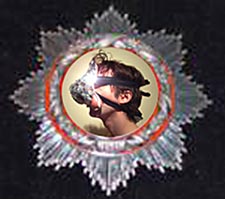 'These days I've been looking with horror and fascination at the process of nation building Germany underwent in the late 19th and 20th centuries. What do German nationalism and my studio practice have in common?' (Brian Getnick)
'These days I've been looking with horror and fascination at the process of nation building Germany underwent in the late 19th and 20th centuries. What do German nationalism and my studio practice have in common?' (Brian Getnick)
'Einigkeit und Recht und Freiheit', so the opening words of the national anthem of Germany today, the third stanza of the Song of the Germans. This single song, used and abused, reveals the extreme controversial history of a nation, the first stanza since WW II being banned, but yet well-known abroad, the memory giving a shiver and the notion of horror in view of to what extents nationalism can be atrocious and definitely lethal. The long process of nation building in Germany, from the initial wish to establish a unifying constitution with guaranteed human rights, following the ideas from French Revolution, surpassed its goal and led to infinite nationalism. The leading role of Prussia with its extremely militaristic attitude forced an imperialistic course and got in friction with neighbouring countries. After a short period of peace after WW I, the antidemocratic tendency culminated in Hitler's Enabling Act, the totalitarian regime of Nazi Germany terrified the entire world. No words for this catastrophe… Harmless and pacific (is this credible?), that is the outward appearance of the nation Germany today, the shame of the past stills weighs heavily, prohibiting specifically every demonstration of military power. No more public military marches, acclaimed from the masses, the national identity troubled forever: a pile of shards.
Brian Getnick operates in this mine field, a sore spot in history, not only for the German people. In his current exhibition at the Gallery UNO, he reduces the exhibited works to a minimum, his sculptural installation and collages conquering the gallery space. The exhibition is closely related to the artist Ryan Swanson, displaying his sculptural work in the upcoming exhibition.
Sculptural installation: For Brian Getnick, they are manifest mnemonic substitutes for floating and fleeting, but virulent tales. He lets the past resurge, lines up ghosts and coevals, pointing out and ridiculing the truly fascinating aspects of power, this dangerous mixture of violence and absurdness: The almost obscene presentation of weapons and military potency, the methods of wielding power, the necessary hierarchical structure of command, the range of 'accessories', degrees defining the rank of everyone involved in a authoritarian system, enthusing the masses, the LOYAL SUBJECTS, through propagandistic paroles.
Rendering homage to the leader, the cult of his personality, which psychological means are necessary to create, in its hysteria, a loyal crowd? Who are the leaders today? In the end it's all a matter of PR!
BRIAN GETNICK was born in Utica New York in 1976. He graduated from Vassar College in 1998 with a BA in Studio Art and received his MFA in 2004 from the School of the Art Institute of Chicago. Brian Getnick has exhibited in group shows in Chicago, New York, Den Haag and Rome and had his first solo show at the Lisa Boyle Gallery in Chicago in 2005.
ARTexhibitionLink.com
www.artexhibitionlink.com
STOCK EXCHANGE: MARK GALLAY with JOZEF E. AMADO - MORNING PROCESS
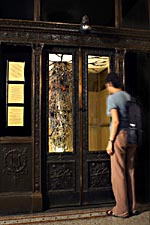 A gallery - institution, place, where people join, coming together with prevalent expectations and following the common procedure: Come in and find out. The 'white cube' of the gallery, since the 1970ies developed as the most functional method of presenting art and creating its value, satisfies the needs of all parties concerned: Artists, public, press… Usually! Mark Gallay and Jozef E. Amado problematize this traditional frame of exhibition measure, questioning sense and signification, borders and opportunities of the hallowed ground (and walls) of the gallery, its autarkic entity, its rigid distinction between 'in' and 'out'.
A gallery - institution, place, where people join, coming together with prevalent expectations and following the common procedure: Come in and find out. The 'white cube' of the gallery, since the 1970ies developed as the most functional method of presenting art and creating its value, satisfies the needs of all parties concerned: Artists, public, press… Usually! Mark Gallay and Jozef E. Amado problematize this traditional frame of exhibition measure, questioning sense and signification, borders and opportunities of the hallowed ground (and walls) of the gallery, its autarkic entity, its rigid distinction between 'in' and 'out'.
In their installation MORNING PROCESS, they resist the osmotic pressure, the almost inescapable drive from people entering and leaving an exhibition space, and transform the formerly penetrable space to a visually semi-permeable box. The public, expected, nearly condemned to remain outside the gallery, is, however, far from being excluded from the exhibition. During the ten days the show 'works', the 'visitors' are invited to witness a process, the MORNING PROCESS. The morning: A blind spot, the time of day having nothing to do at all with gallery practise preferring the evening hours. Thus Mark Gallay and Jozef E. Amado spread out every morning collecting and gathering morning impressions. They deliver their report in the afternoon, switching and compressing the wide outside world into the narrow gallery space, taking it out of context and Central European Time.
The process procedure: Each morning: Ten minutes sound recording in different places, ten minutes video, distinct from the sound recording. Writing x words long lines for x minutes (Equation X = (day of the month) - 4). Each day being defined and related to opening at August 4th, lines and words are subsequently increasing during the exhibition period.
Each afternoon: Playing of the sound back over speakers inside the gallery, the video being projected from the inside onto the white and opaque windows of the gallery used as screen. The lines written in the morning are added on the sheet of paper hanging in the gallery window facing out, the text progressing and growing…
Audible rather than visible, diffuse, poetic and algebraical: MORNING PROCCES is appealing to imagination, the concise perception is disturbed, confused. What will we see or recognize through the milky glass? Will the sound be able to escape and reach our ear? And: What happens, when senses are no longer reliable, when sights are clouded? To what extend do we need to compensate for the missing links with our own inventions to make sense of something? Mark Gallay's and Jozef E. Amado's research, recording and combining sound, video projection, drawing and live performance in a mixed media installation, is consequently reversing in- and outside, in every direction.
My orientation to the world is largely through sound. In my current work this is made manifest in the complex relationship that sound has with materials and their environments. I explore sound in relationship with site-specific sculpture. I am interested in exploring new methods of merging sound and image in ways that reanimate the found object.
My goal as an artist is to explore the world in a quest for the best questions. I believe that my role is not to provide answers or resolve paradoxes - but to identify and explore problems, marvel at their intricacy and contingency, arbitrary and sometimes labyrinthine nature.
MARK GALLAY was born in NYC in 1972. He received a B.A. from Vassar College in 1994 and an M.F.A. from the School of the Art Institute of Chicago in May 2006. His work has recently been shown at the Hyde Park Art Center and SubCity Projects (w/ Dianna Frid), Lisa Boyle Gallery (w/ Brian Getnick), Contemporary Arts Workshop (w/ Noe Kidder), Chicago Filmmakers (w/ Jim Trainor), Mess Hall, Heaven Gallery, and PAC/EDGE Festival.
JOZEF ERCEVIK AMADO was born in Southport, England in 1980 and grew up in Turkey. He received his B.A. from Bates College in 2003 and his M.F.A. from School of the Art Institute of Chicago in 2006. He has recently performed at 1926 Gallery, PAC/Edge Festival, Istanbul Biennial, the Chicago MCA, Peter Jones Gallery and Spareroom.
ARTexhibitionLink.com
www.artexhibitionlink.com
STOCK EXCHANGE: NOE KIDDER
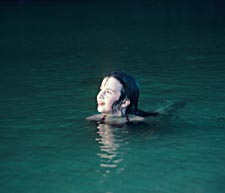 A young girl swimming in Hawaiian stream: Enjoying her movements, her vital force in the refreshing water, savouring the surrounding nature, being part of it. The expression of joy upon her face hints at another secret knowledge, which most children are blessed with: With the subcutaneous insight in a world beyond the surface of the visible and normal course of life, they are able to perceive their environment as animated. Untouched by logical coherencies and with no need of cognitive performance, the interrelation of matters is grasped intuitively. Plants and trees, objects of everyday life are attributed with souls; the childhood's universe is thus densely populated and exciting.
A young girl swimming in Hawaiian stream: Enjoying her movements, her vital force in the refreshing water, savouring the surrounding nature, being part of it. The expression of joy upon her face hints at another secret knowledge, which most children are blessed with: With the subcutaneous insight in a world beyond the surface of the visible and normal course of life, they are able to perceive their environment as animated. Untouched by logical coherencies and with no need of cognitive performance, the interrelation of matters is grasped intuitively. Plants and trees, objects of everyday life are attributed with souls; the childhood's universe is thus densely populated and exciting.
Many natural and syncretic religious traditions preserve this kind of awareness in their culture and rituals, life and death are interwoven, spirits are all around.
This large format photograph, which Noe Kidder displays in her solo exhibition at Gallery Uno in Chicago's Fine Arts Building, is entitled 'Rose of Sharon', referring to the Song of Solomon in the Old Testament, a sublime poem of love. Assuming Jesus being the Rose of Sharon himself, the flower turns into a symbol of generous love, a love spread from nature and being returned from humans in flaming celebration.
Flames and fire are echoed by Noe Kidder's movie 'Rx for Fire', constructed from found film footage concerning instructional safety in the 1970es. The montage is accompanied by a soundtrack, Nina Simone singing with her incomparable voice.
Rx, mysterious abbreviation, is used, amongst others, to indicate a prescription. Either for medicament or drug or for a controlled fire for clearing or in order to put another fire out, Rx is pure definition of man-made realm. Fire, the spiritual and elementary force, is reduced to scientific level; its physical properties are studied to make it calculable. But the illusory attempts to master powerful natural forces, the loss of respect must lead to failure: Nature rules.
Rx is also a technical term of radio communication, an abbreviation indicating the receiver…
Why does she sell herself? There is the money and the dancing and we all can see she's good at that. She says it makes her feel powerful. Others are convinced of an abuse in her past, and therefore a need to be exploited. But none of that's true. This is an art, an exchange like all the others. Here is her studio reproduced, a place to exist apart from life.
Noe Kidder is concerned about the possibilities of transmission. The combination of photograph and movie in this exhibition, the composition of visuals and Nina Simone's velvet voice conjures images of …what, in fact? Noe Kidder, the enchantress, evokes a world eluding all description. But the images, welling from deep sources of the 'receiver's' inner world, are, surprisingly, well-known acquaintances, familiar places he has never seen in reality, sensations and memories drawn to the light from the exile of oblivion.
NOE KIDDER was born in Syracuse, NY in 1974. She has spent a significant part of her life in Hawaii. She received her Master in Fine Arts from the School of the Art Institute of Chicago, a Master of Education from Columbia University Teachers College, and a Bachelor of Arts in Studio Art from Vassar College. Her films have been shown recently at Lichtblick Kino, Berlin, Chicago Underground Film Festival, and the Empty Vessel Project in New York City.
ARTexhibitionLink.com
www.artexhibitionlink.com
STOCK EXCHANGE: RYAN SWANSON
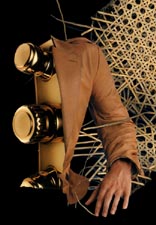 I find material for my collages from fashion magazines, advertising, and other photographic sources. Through the re-editing processes of cutting and Photoshop, I seek to break the implicit hierarchies of our natural and social orders. The result of re-organizing the common relationships between clothing, bodies, furniture, and spaces, prompts a newfound perception of the ordinary. I conduct scenes whereby objects and people behave in unexpected ways.
I find material for my collages from fashion magazines, advertising, and other photographic sources. Through the re-editing processes of cutting and Photoshop, I seek to break the implicit hierarchies of our natural and social orders. The result of re-organizing the common relationships between clothing, bodies, furniture, and spaces, prompts a newfound perception of the ordinary. I conduct scenes whereby objects and people behave in unexpected ways.
Commodities flirt with fractioned bodies in an eerily sensual way. Precious goods secrete bodily forms; limbs accrete into polymorphous structures reminiscent of furniture; the figure penetrates the ground; the ground digests the figure
ARTexhibitionLink.com
www.artexhibitionlink.com
|





